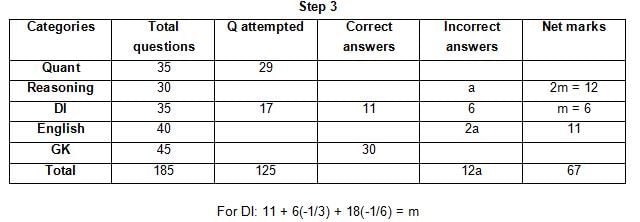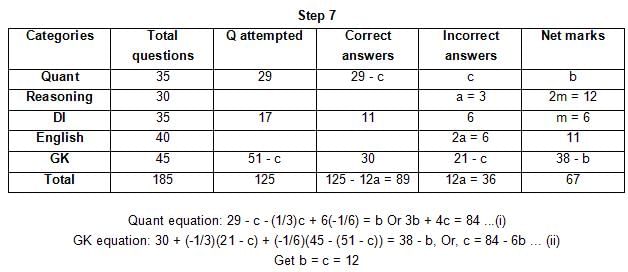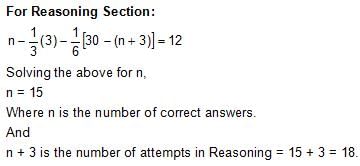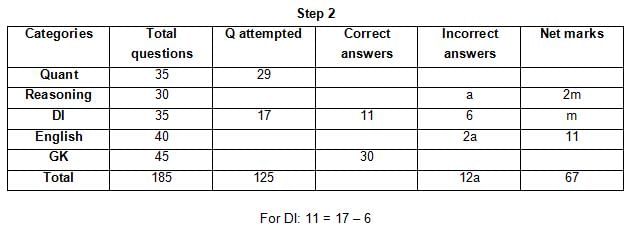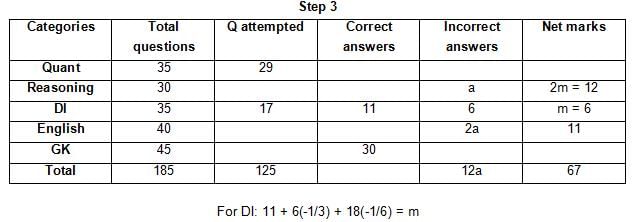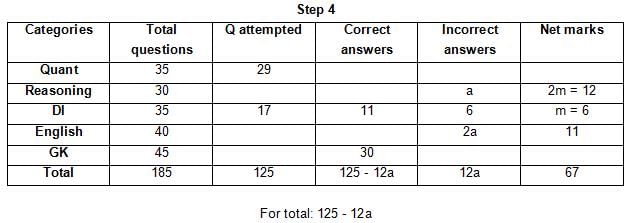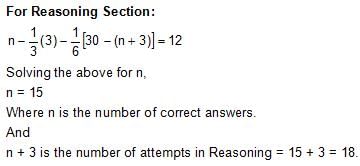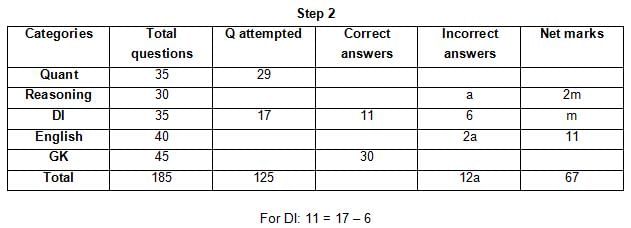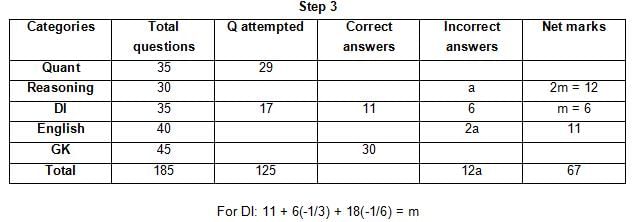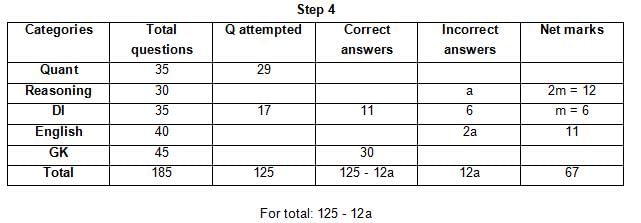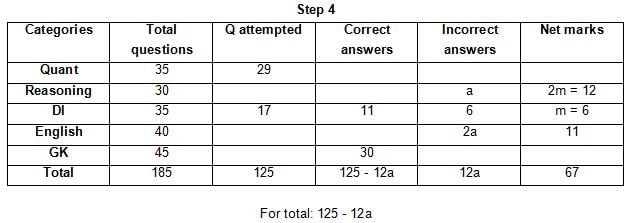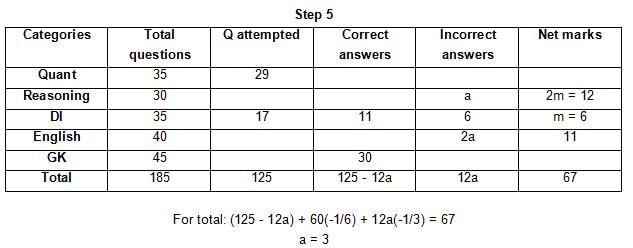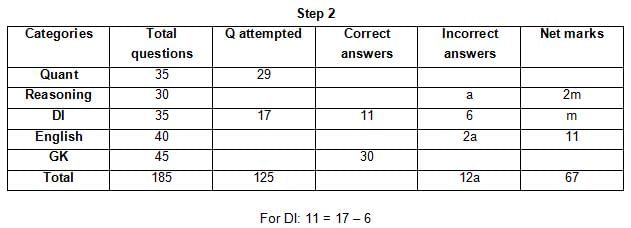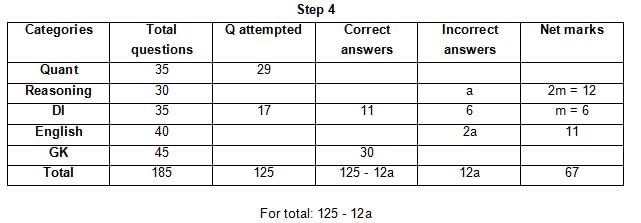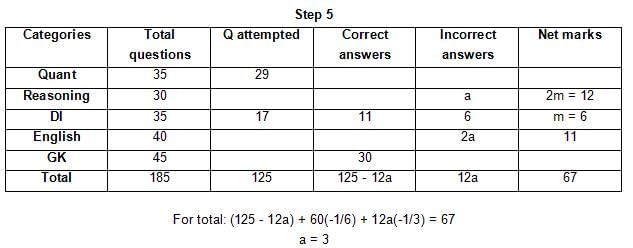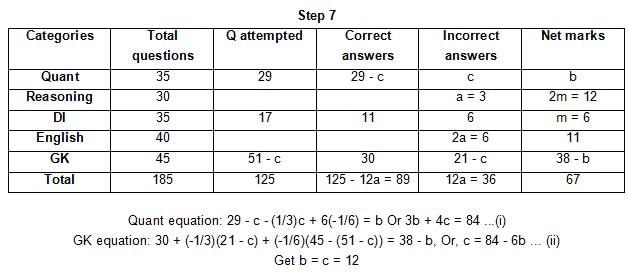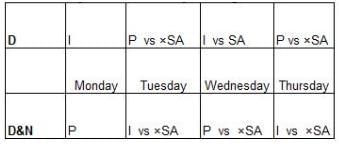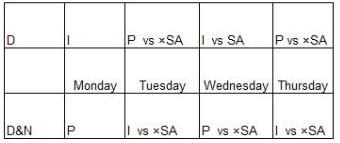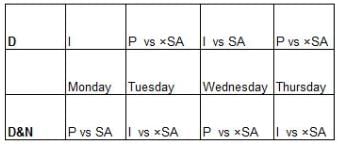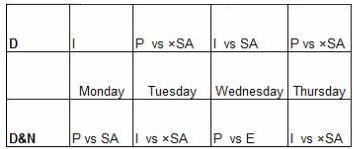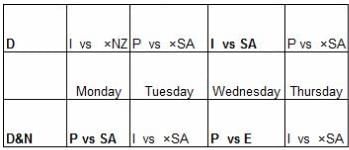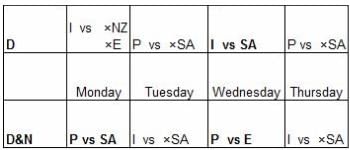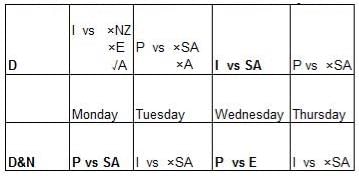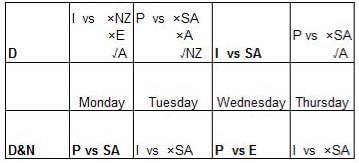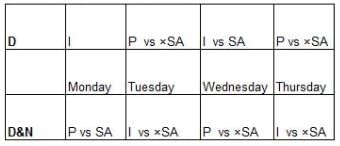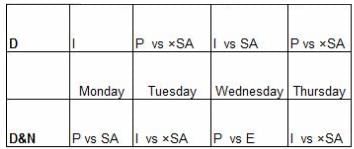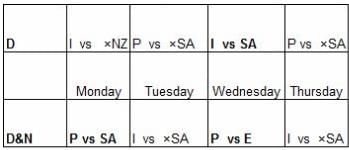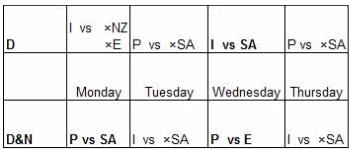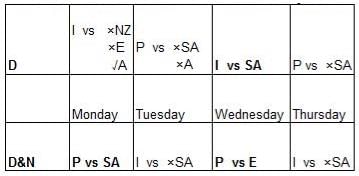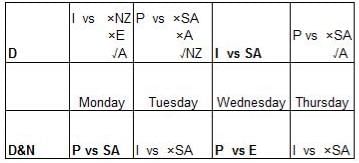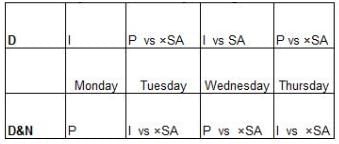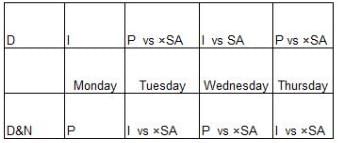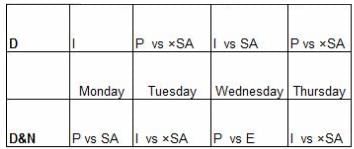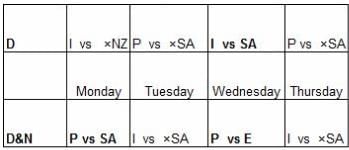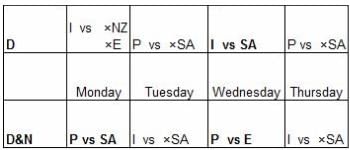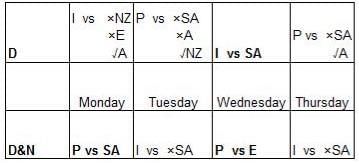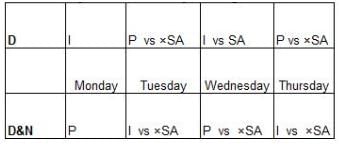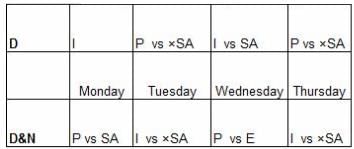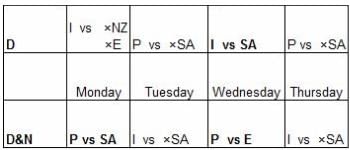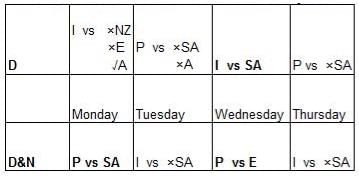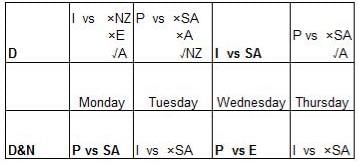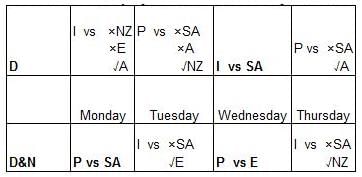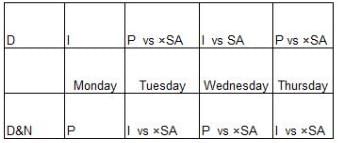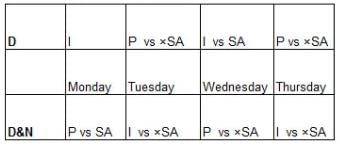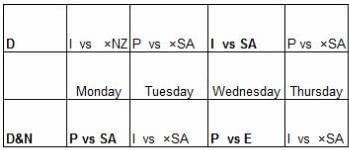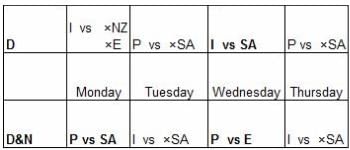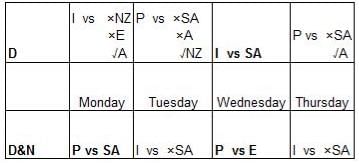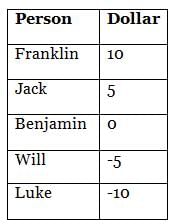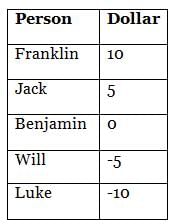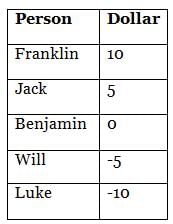Test: CAT Logical Reasoning & Data Interpretation- 6 - CAT MCQ
20 Questions MCQ Test - Test: CAT Logical Reasoning & Data Interpretation- 6
Directions: Answer the given question based on the following data:
The following table provides the data of local and STD call rates from the network of one company to the network of another company.

Values are in Rs. per call
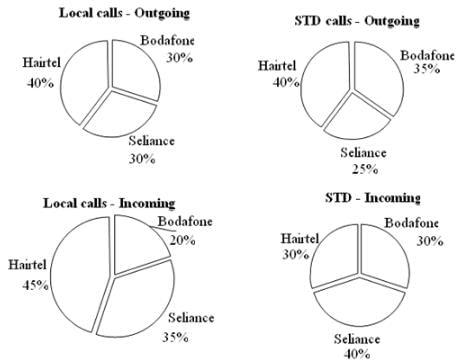
(i) The maximum possible Local and STD calls are being done between the same networks unless mentioned otherwise (i.e. Hairtel to Hairtel, Bodafone to Bodafone and so on).
(ii) Bodafone Local calls that are not to Bodafone are equally distributed to other networks.
(iii) There are no other telecom companies and networks in India.
(iv) ARPU is defined as Average Revenue per Customer per month.
Q. In November, the number of outgoing Local calls is 7.5 million and the number of incoming STD calls is 3 million. What is the ratio of revenues of Hairtel and Bodafone in November?

Values are in Rs. per call

(i) The maximum possible Local and STD calls are being done between the same networks unless mentioned otherwise (i.e. Hairtel to Hairtel, Bodafone to Bodafone and so on).
(ii) Bodafone Local calls that are not to Bodafone are equally distributed to other networks.
(iii) There are no other telecom companies and networks in India.
(iv) ARPU is defined as Average Revenue per Customer per month.
Directions: Answer the given question based on the following data:
The following table provides the data of local and STD call rates from the network of one company to the network of another company.

Values are in Rs. per call

(i) The maximum possible Local and STD calls are being done between the same networks unless mentioned otherwise (i.e. Hairtel to Hairtel, Bodafone to Bodafone and so on).
(ii) Bodafone Local calls that are not to Bodafone are equally distributed to other networks.
(iii) There are no other telecom companies and networks in India.
(iv) ARPU is defined as Average Revenue per Customer per month.
Q. In November, the number of outgoing Local calls is 7.5 million and the number of incoming STD calls is 3 million. If Seliance has 1 lac phone connections, what is its ARPU (one phone connection is the same as one customer)?

Values are in Rs. per call

(i) The maximum possible Local and STD calls are being done between the same networks unless mentioned otherwise (i.e. Hairtel to Hairtel, Bodafone to Bodafone and so on).
(ii) Bodafone Local calls that are not to Bodafone are equally distributed to other networks.
(iii) There are no other telecom companies and networks in India.
(iv) ARPU is defined as Average Revenue per Customer per month.
Directions: Answer the given question based on the following data:
The following table provides the data of local and STD call rates from the network of one company to the network of another company.

Values are in Rs. per call

(i) The maximum possible Local and STD calls are being done between the same networks unless mentioned otherwise (i.e. Hairtel to Hairtel, Bodafone to Bodafone and so on).
(ii) Bodafone Local calls that are not to Bodafone are equally distributed to other networks.
(iii) There are no other telecom companies and networks in India.
(iv) ARPU is defined as Average Revenue per Customer per month.
Q. Seliance wants to become number 1 company (revenue wise). Its incoming calls and outgoing calls are the same as the calls in November month. By what % Seliance should increase its STD rate (Seliance to Seliance) to become number 1, other rates being constant?

Values are in Rs. per call

(i) The maximum possible Local and STD calls are being done between the same networks unless mentioned otherwise (i.e. Hairtel to Hairtel, Bodafone to Bodafone and so on).
(ii) Bodafone Local calls that are not to Bodafone are equally distributed to other networks.
(iii) There are no other telecom companies and networks in India.
(iv) ARPU is defined as Average Revenue per Customer per month.
Directions: Answer the given question based on the following data:
The following table provides the data of local and STD call rates from the network of one company to the network of another company.

Values are in Rs. per call
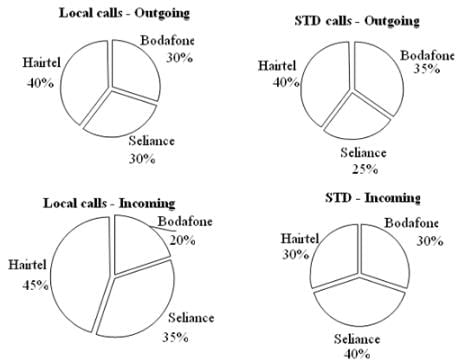
(i) The maximum possible Local and STD calls are being done between the same networks unless mentioned otherwise (i.e. Hairtel to Hairtel, Bodafone to Bodafone and so on).
(ii) Bodafone Local calls that are not to Bodafone are equally distributed to other networks.
(iii) There are no other telecom companies and networks in India.
(iv) ARPU is defined as Average Revenue per Customer per month.
Q. If for each incoming call, the company gets 25 paisa from the company (from which the call is sent), what is the difference between the revenue of Seliance and that of Bodafone (in Rs. lakhs)?
Directions: Study the given information and answer the following question.
The table below gives some information about marks scored by Joey in a written exam for University Professor, which consists of five main categories: Quant, Reasoning, DI, English, and General Knowledge
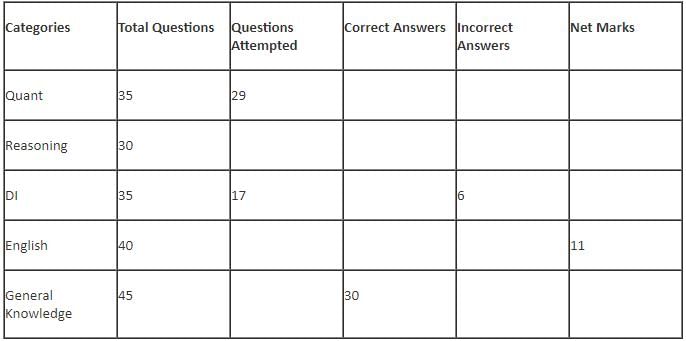
The following data is also provided:
(1) For every correct answer, the candidate gets one mark, for every un-attempted question, the candidate loses 1/6 of a mark, and for every incorrect answer, the student loses 1/3 of a mark.
(2) Joey scores 67 marks and he attempts 125 questions.
(3) The number of incorrect answers given by Joey in English is 1/6 of total number of incorrect answers and twice the number of incorrect answers in Reasoning.
(4) Joey's net marks in Reasoning are double than those in DI.
Q. Key in the total number of incorrect answers given by Jeoy in Reasoning.
Directions: Study the given information and answer the following question.
The table below gives some information about marks scored by Joey in a written exam for University Professor, which consists of five main categories: Quant, Reasoning, DI, English, and General Knowledge
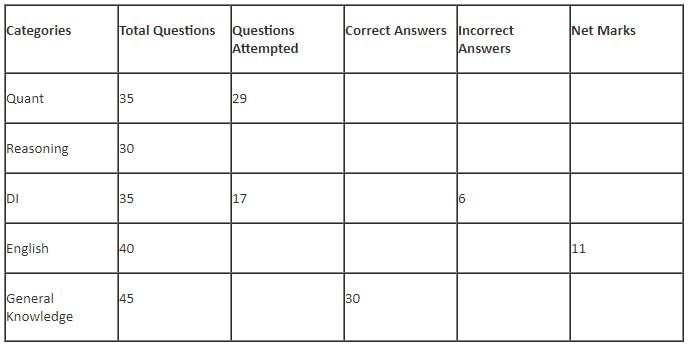
The following data is also provided:
(1) For every correct answer, the candidate gets one mark, for every un-attempted question, the candidate loses 1/6 of a mark, and for every incorrect answer, the student loses 1/3 of a mark.
(2) Joey scores 67 marks and he attempts 125 questions.
(3) The number of incorrect answers given by Joey in English is 1/6 of total number of incorrect answers and twice the number of incorrect answers in Reasoning.
(4) Joey's net marks in Reasoning are double than those in DI.
Q. The highest number of incorrect answers given by Joey in any category is ____.
Directions: Study the given information and answer the following question.
The table below gives some information about marks scored by Joey in a written exam for University Professor, which consists of five main categories: Quant, Reasoning, DI, English, and General Knowledge
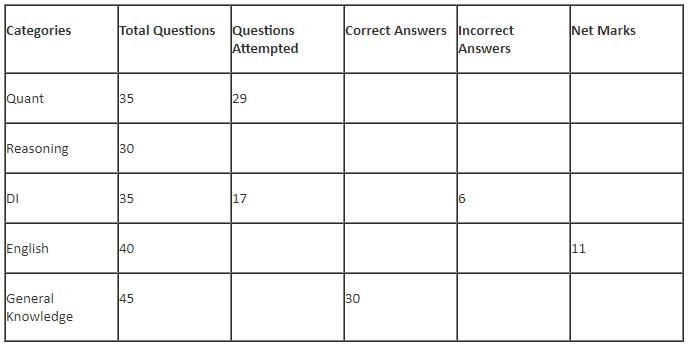
The following data is also provided:
(1) For every correct answer, the candidate gets one mark, for every un-attempted question, the candidate loses 1/6 of a mark, and for every incorrect answer, the student loses 1/3 of a mark.
(2) Joey scores 67 marks and he attempts 125 questions.
(3) The number of incorrect answers given by Joey in English is 1/6 of total number of incorrect answers and twice the number of incorrect answers in Reasoning.
(4) Joey's net marks in Reasoning are double than those in DI.
Q. Key in the number of questions attempted by Joey in Reasoning.
Directions: Study the given information and answer the following question.
The table below gives some information about marks scored by Joey in a written exam for University Professor, which consists of five main categories: Quant, Reasoning, DI, English, and General Knowledge
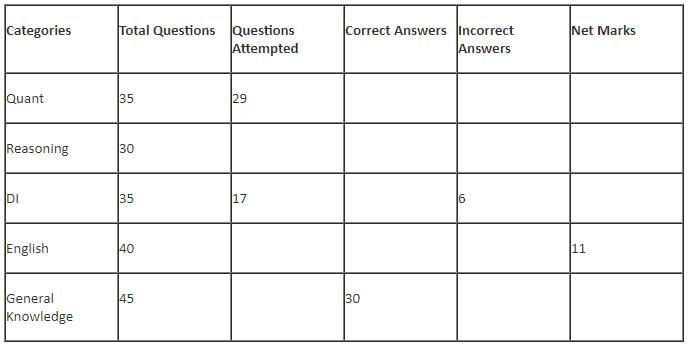
The following data is also provided:
(1) For every correct answer, the candidate gets one mark, for every un-attempted question, the candidate loses 1/6 of a mark, and for every incorrect answer, the student loses 1/3 of a mark.
(2) Joey scores 67 marks and he attempts 125 questions.
(3) The number of incorrect answers given by Joey in English is 1/6 of total number of incorrect answers and twice the number of incorrect answers in Reasoning.
(4) Joey's net marks in Reasoning are double than those in DI.
Q. What is the percentage accuracy of Joey in the examination?
Directions: Study the given information and answer the following question.
The table below gives some information about marks scored by Joey in a written exam for University Professor, which consists of five main categories: Quant, Reasoning, DI, English, and General Knowledge
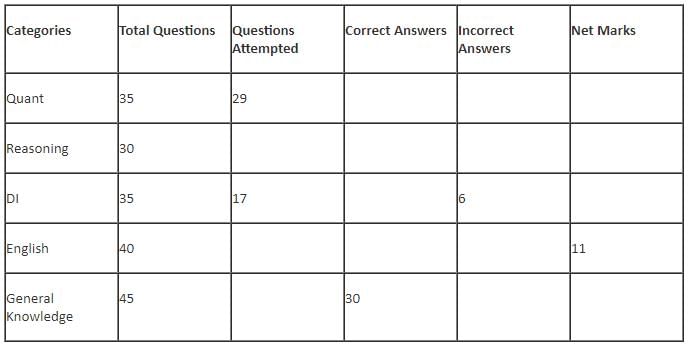
The following data is also provided:
(1) For every correct answer, the candidate gets one mark, for every un-attempted question, the candidate loses 1/6 of a mark, and for every incorrect answer, the student loses 1/3 of a mark.
(2) Joey scores 67 marks and he attempts 125 questions.
(3) The number of incorrect answers given by Joey in English is 1/6 of total number of incorrect answers and twice the number of incorrect answers in Reasoning.
(4) Joey's net marks in Reasoning are double than those in DI.
Q. What is the ratio of the number of questions attempted to the number of incorrect answers?
Directions: Study the given information carefully and answer the following question.
In the 20-20 World Cup 2007, India played exactly one match with each of New Zealand, England, Australia and South Africa. Pakistan also played exactly one match with each of these 4 teams.
Out of these 8 matches, 4 were day matches and 4 were day and night matches. Each day from Monday to Thursday, two matches were played, one day match and other day and night match.
It is also known that:
1. India vs England and Pakistan vs South Africa were not held on the same day.
2. New Zealand and South Africa did not play a match on the same day.
3. India and Pakistan both played 2-day matches and 2 day and night matches.
4. Neither India nor Pakistan played two consecutive day matches or two consecutive day and night matches.
5. Pakistan vs England match was a day and night match.
6. India vs South Africa match was a day match on Wednesday.
7. England is the only team which played on consecutive days.
Q. India vs Australia match was held on
Directions: Study the given information carefully and answer the following question.
In the 20-20 World Cup 2007, India played exactly one match with each of New Zealand, England, Australia and South Africa. Pakistan also played exactly one match with each of these 4 teams.
Out of these 8 matches, 4 were day matches and 4 were day and night matches. Each day from Monday to Thursday, two matches were played, one day match and other day and night match.
It is also known that:
1. India vs England and Pakistan vs South Africa were not held on the same day.
2. New Zealand and South Africa did not play a match on the same day.
3. India and Pakistan both played 2-day matches and 2 day and night matches.
4. Neither India nor Pakistan played two consecutive day matches or two consecutive day and night matches.
5. Pakistan vs England match was a day and night match.
6. India vs South Africa match was a day match on Wednesday.
7. England is the only team which played on consecutive days.
Q. Which of the following matches was a day and night match held on Monday?
Directions: Study the given information carefully and answer the following question.
In the 20-20 World Cup 2007, India played exactly one match with each of New Zealand, England, Australia and South Africa. Pakistan also played exactly one match with each of these 4 teams.
Out of these 8 matches, 4 were day matches and 4 were day and night matches. Each day from Monday to Thursday, two matches were played, one day match and other day and night match.
It is also known that:
1. India vs England and Pakistan vs South Africa were not held on the same day.
2. New Zealand and South Africa did not play a match on the same day.
3. India and Pakistan both played 2-day matches and 2 day and night matches.
4. Neither India nor Pakistan played two consecutive day matches or two consecutive day and night matches.
5. Pakistan vs England match was a day and night match.
6. India vs South Africa match was a day match on Wednesday.
7. England is the only team which played on consecutive days.
Q. Which of the following statements is false?
Directions: Study the given information carefully and answer the following question.
In the 20-20 World Cup 2007, India played exactly one match with each of New Zealand, England, Australia and South Africa. Pakistan also played exactly one match with each of these 4 teams.
Out of these 8 matches, 4 were day matches and 4 were day and night matches. Each day from Monday to Thursday, two matches were played, one day match and other day and night match.
It is also known that:
1. India vs England and Pakistan vs South Africa were not held on the same day.
2. New Zealand and South Africa did not play a match on the same day.
3. India and Pakistan both played 2-day matches and 2 day and night matches.
4. Neither India nor Pakistan played two consecutive day matches or two consecutive day and night matches.
5. Pakistan vs England match was a day and night match.
6. India vs South Africa match was a day match on Wednesday.
7. England is the only team which played on consecutive days.
Q. Which of the following schedules was wrong?
Directions: Study the given information carefully and answer the following question.
In the 20-20 World Cup 2007, India played exactly one match with each of New Zealand, England, Australia and South Africa. Pakistan also played exactly one match with each of these 4 teams.
Out of these 8 matches, 4 were day matches and 4 were day and night matches. Each day from Monday to Thursday, two matches were played, one day match and other day and night match.
It is also known that:
1. India vs England and Pakistan vs South Africa were not held on the same day.
2. New Zealand and South Africa did not play a match on the same day.
3. India and Pakistan both played 2-day matches and 2 day and night matches.
4. Neither India nor Pakistan played two consecutive day matches or two consecutive day and night matches.
5. Pakistan vs England match was a day and night match.
6. India vs South Africa match was a day match on Wednesday.
7. England is the only team which played on consecutive days.
Q. Which among the four teams completed their matches before the last scheduled day of play?
Directions: Read the information given below and answer the question that follows.
Five players — Jack, Will, Luke, Benjamin and Franklin —participated in an innovative game show on a slot machine. At the beginning of the game, the five players were asked to stand in a queue, one behind the other, facing the same direction. Whenever a dealer called any player to the slot machine, the player who was called by the dealer had to move to the front of the queue (irrespective of whether his get was correct or not) and the others moved back in the queue, without any other rearrangement. For example, if the third player in the queue was called by the dealer, he had to move to the first position and the players who were earlier in the first and second positions moved to the second and third positions, respectively, while the players in the fourth and fifth positions did not move. Also, exactly one player rolled the slot machine in each attempt. The game had a total of six attempts, and every jackpot hit was awarded 10 dollars and when jackpot was not hit, it carried a penalty of 5 dollars. It is known that no two players had the same number of dollars at the end of the game.
It is given that every player had same amount of money in their pocket before the start of the game. Further, the following information is known about their positions in the queue at various stages of the game:
(i) Jack was the only player to get two attempts consecutively and he did not get the first attempt.
(ii) During the fourth attempt, Will moved from a position behind Franklin to a position in front of him and during the fifth attempt, Luke moved from a position behind Jack to a position in front of him.
(iii) Benjamin who was initially (i.e. before the first attempt of the game) at the beginning of the queue moved to the last position in the queue by the end of the game.
(iv) The sum of the dollars received by the five players was zero and the player who rolled the slot machine in the last attempt won the game.
(v) The player who rolled the slot machine in the first attempt had the least number of dollars in the game.
(vi) Jack was further ahead in the queue at the end of the game than at the beginning.
Q. Who stood first in the game?
Directions: Read the information given below and answer the question that follows.
Five players — Jack, Will, Luke, Benjamin and Franklin —participated in an innovative game show on a slot machine. At the beginning of the game, the five players were asked to stand in a queue, one behind the other, facing the same direction. Whenever a dealer called any player to the slot machine, the player who was called by the dealer had to move to the front of the queue (irrespective of whether his get was correct or not) and the others moved back in the queue, without any other rearrangement. For example, if the third player in the queue was called by the dealer, he had to move to the first position and the players who were earlier in the first and second positions moved to the second and third positions, respectively, while the players in the fourth and fifth positions did not move. Also, exactly one player rolled the slot machine in each attempt. The game had a total of six attempts, and every jackpot hit was awarded 10 dollars and when jackpot was not hit, it carried a penalty of 5 dollars. It is known that no two players had the same number of dollars at the end of the game.
It is given that every player had same amount of money in their pocket before the start of the game. Further, the following information is known about their positions in the queue at various stages of the game:
(i) Jack was the only player to get two attempts consecutively and he did not get the first attempt.
(ii) During the fourth attempt, Will moved from a position behind Franklin to a position in front of him and during the fifth attempt, Luke moved from a position behind Jack to a position in front of him.
(iii) Benjamin who was initially (i.e. before the first attempt of the game) at the beginning of the queue moved to the last position in the queue by the end of the game.
(iv) The sum of the dollars received by the five players was zero and the player who rolled the slot machine in the last attempt won the game.
(v) The player who rolled the slot machine in the first attempt had the least number of dollars in the game.
(vi) Jack was further ahead in the queue at the end of the game than at the beginning.
Q. Who was at the fourth position from the bottom at the starting of the third attempt?
Directions: Read the information given below and answer the question that follows.
Five players — Jack, Will, Luke, Benjamin and Franklin —participated in an innovative game show on a slot machine. At the beginning of the game, the five players were asked to stand in a queue, one behind the other, facing the same direction. Whenever a dealer called any player to the slot machine, the player who was called by the dealer had to move to the front of the queue (irrespective of whether his get was correct or not) and the others moved back in the queue, without any other rearrangement. For example, if the third player in the queue was called by the dealer, he had to move to the first position and the players who were earlier in the first and second positions moved to the second and third positions, respectively, while the players in the fourth and fifth positions did not move. Also, exactly one player rolled the slot machine in each attempt. The game had a total of six attempts, and every jackpot hit was awarded 10 dollars and when jackpot was not hit, it carried a penalty of 5 dollars. It is known that no two players had the same number of dollars at the end of the game.
It is given that every player had same amount of money in their pocket before the start of the game. Further, the following information is known about their positions in the queue at various stages of the game:
(i) Jack was the only player to get two attempts consecutively and he did not get the first attempt.
(ii) During the fourth attempt, Will moved from a position behind Franklin to a position in front of him and during the fifth attempt, Luke moved from a position behind Jack to a position in front of him.
(iii) Benjamin who was initially (i.e. before the first attempt of the game) at the beginning of the queue moved to the last position in the queue by the end of the game.
(iv) The sum of the dollars received by the five players was zero and the player who rolled the slot machine in the last attempt won the game.
(v) The player who rolled the slot machine in the first attempt had the least number of dollars in the game.
(vi) Jack was further ahead in the queue at the end of the game than at the beginning.
Q. Which of the following cannot be the sum of amount with any three players out of total five?
Directions: Read the information given below and answer the question that follows.
Five players — Jack, Will, Luke, Benjamin and Franklin —participated in an innovative game show on a slot machine. At the beginning of the game, the five players were asked to stand in a queue, one behind the other, facing the same direction. Whenever a dealer called any player to the slot machine, the player who was called by the dealer had to move to the front of the queue (irrespective of whether his get was correct or not) and the others moved back in the queue, without any other rearrangement. For example, if the third player in the queue was called by the dealer, he had to move to the first position and the players who were earlier in the first and second positions moved to the second and third positions, respectively, while the players in the fourth and fifth positions did not move. Also, exactly one player rolled the slot machine in each attempt. The game had a total of six attempts, and every jackpot hit was awarded 10 dollars and when jackpot was not hit, it carried a penalty of 5 dollars. It is known that no two players had the same number of dollars at the end of the game.
It is given that every player had same amount of money in their pocket before the start of the game. Further, the following information is known about their positions in the queue at various stages of the game:
(i) Jack was the only player to get two attempts consecutively and he did not get the first attempt.
(ii) During the fourth attempt, Will moved from a position behind Franklin to a position in front of him and during the fifth attempt, Luke moved from a position behind Jack to a position in front of him.
(iii) Benjamin who was initially (i.e. before the first attempt of the game) at the beginning of the queue moved to the last position in the queue by the end of the game.
(iv) The sum of the dollars received by the five players was zero and the player who rolled the slot machine in the last attempt won the game.
(v) The player who rolled the slot machine in the first attempt had the least number of dollars in the game.
(vi) Jack was further ahead in the queue at the end of the game than at the beginning.
Q. What is the difference between the amounts (in $) with Benjamin and Will?
Directions: Read the information given below and answer the question that follows.
Five players — Jack, Will, Luke, Benjamin and Franklin —participated in an innovative game show on a slot machine. At the beginning of the game, the five players were asked to stand in a queue, one behind the other, facing the same direction. Whenever a dealer called any player to the slot machine, the player who was called by the dealer had to move to the front of the queue (irrespective of whether his get was correct or not) and the others moved back in the queue, without any other rearrangement. For example, if the third player in the queue was called by the dealer, he had to move to the first position and the players who were earlier in the first and second positions moved to the second and third positions, respectively, while the players in the fourth and fifth positions did not move. Also, exactly one player rolled the slot machine in each attempt. The game had a total of six attempts, and every jackpot hit was awarded 10 dollars and when jackpot was not hit, it carried a penalty of 5 dollars. It is known that no two players had the same number of dollars at the end of the game.
It is given that every player had same amount of money in their pocket before the start of the game. Further, the following information is known about their positions in the queue at various stages of the game:
(i) Jack was the only player to get two attempts consecutively and he did not get the first attempt.
(ii) During the fourth attempt, Will moved from a position behind Franklin to a position in front of him and during the fifth attempt, Luke moved from a position behind Jack to a position in front of him.
(iii) Benjamin who was initially (i.e. before the first attempt of the game) at the beginning of the queue moved to the last position in the queue by the end of the game.
(iv) The sum of the dollars received by the five players was zero and the player who rolled the slot machine in the last attempt won the game.
(v) The player who rolled the slot machine in the first attempt had the least number of dollars in the game.
(vi) Jack was further ahead in the queue at the end of the game than at the beginning.
Q. Who among the following was/were in debt at the end of the game?
Directions: Read the information given below and answer the question that follows.
Five players — Jack, Will, Luke, Benjamin and Franklin —participated in an innovative game show on a slot machine. At the beginning of the game, the five players were asked to stand in a queue, one behind the other, facing the same direction. Whenever a dealer called any player to the slot machine, the player who was called by the dealer had to move to the front of the queue (irrespective of whether his get was correct or not) and the others moved back in the queue, without any other rearrangement. For example, if the third player in the queue was called by the dealer, he had to move to the first position and the players who were earlier in the first and second positions moved to the second and third positions, respectively, while the players in the fourth and fifth positions did not move. Also, exactly one player rolled the slot machine in each attempt. The game had a total of six attempts, and every jackpot hit was awarded 10 dollars and when jackpot was not hit, it carried a penalty of 5 dollars. It is known that no two players had the same number of dollars at the end of the game.
It is given that every player had same amount of money in their pocket before the start of the game. Further, the following information is known about their positions in the queue at various stages of the game:
(i) Jack was the only player to get two attempts consecutively and he did not get the first attempt.
(ii) During the fourth attempt, Will moved from a position behind Franklin to a position in front of him and during the fifth attempt, Luke moved from a position behind Jack to a position in front of him.
(iii) Benjamin who was initially (i.e. before the first attempt of the game) at the beginning of the queue moved to the last position in the queue by the end of the game.
(iv) The sum of the dollars received by the five players was zero and the player who rolled the slot machine in the last attempt won the game.
(v) The player who rolled the slot machine in the first attempt had the least number of dollars in the game.
(vi) Jack was further ahead in the queue at the end of the game than at the beginning.
Q. Which of the following attempts rolled the slot machine to definitely hit the jackpot?




 = 18.75 Rs. per month per customer
= 18.75 Rs. per month per customer


